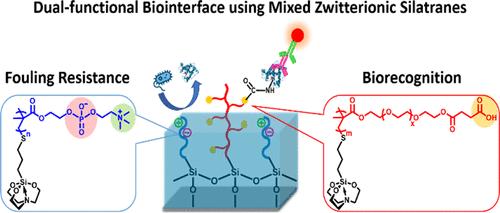利用混合齐聚物硅烷开发功能性生物界面
IF 3.7
2区 化学
Q2 CHEMISTRY, MULTIDISCIPLINARY
引用次数: 0
摘要
为了获得最佳的灵敏度、特异性和准确性,人们广泛研究了为生物传感器设计多功能接口的策略。然而,临床样本中的异质成分不可避免地会产生背景信号,给生物传感器的性能带来挑战。通过提供与生物系统相互作用所必需的定制特性,聚合物涂层已被认为是对生物界面进行功能化的重要方法。在此,我们首次介绍了两种低聚硅烷--MPS-MPCn 和 MPS-PEGMACOOHm,它们是由巯丙基硅烷(MPS)通过巯基-烯基聚合反应,与带共聚单体 2-甲基丙烯酰氧乙基磷酰胆碱(MPC)或羧基聚(乙二醇)甲基丙烯酸酯(PEGMACOOH)共聚而成。在酸性和非酸性溶剂中单独或组合制备了这些低聚硅烷,并将其沉积在硅晶片上。随后,分别通过接触角仪、椭偏仪和 X 射线光电子能谱(XPS)对涂层的特性(包括润湿性、厚度和元素组成)进行了表征。重要的是,研究发现 MPS-MPCn 聚合物形成的薄膜具有高亲水性,对细菌和蛋白质具有优异的防污能力,而 70% MPS-PEGMACOOH2.5 和 30% MPS-MPC2.5 混合涂层在 COOH 端涂层中涂层最薄,润湿性最好。此外,涂层表面的功能性 COOH 基团可通过胺偶联化学方法,以 N-羟基琥珀酰亚胺(NHS)酯基为中间体,进行生物分子的后修饰。同样,70% MPS-PEGMACOOH2.5 和 30% MPS-MPC2.5 的组合最终减少了非特异性吸附(NSA),并通过酶联免疫吸附测定建立了最精细的信号分辨能力。因此,这些新型混合低聚硅烷为构建具有防止非特异性结合和生物分子共轭双重功能的生物传感器界面提供了一种前景广阔的方法。本文章由计算机程序翻译,如有差异,请以英文原文为准。

Development of Functional Biointerface Using Mixed Zwitterionic Silatranes
Strategies to design multifunctional interfaces for biosensors have been extensively investigated to acquire optimal sensitivity, specificity, and accuracy. However, heterogeneous ingredients in clinical samples inevitably generate background signals, exposing challenges in biosensor performance. Polymer coating has been recognized as a crucial method to functionalize biointerfaces by providing tailored properties that are essential for interacting with biological systems. Herein, we introduce for the first time two oligomeric silatranes, MPS–MPCn and MPS–PEGMACOOHm, which were copolymerized from mercaptopropylsilatrane (MPS) with either zwitterionic monomer 2-methacryloyloxyethyl phosphorylcholine (MPC) or carboxylated poly(ethylene glycol) methacrylate (PEGMACOOH) through thiol–ene polymerization. These oligomeric silatranes were prepared individually and in combinations in acidic and nonacid solvents for deposition on silicon wafers. Afterward, coating properties, including wettability, thickness, and elemental composition, were characterized by contact angle meter, ellipsometer, and X-ray photoelectron spectroscopy (XPS), respectively. Importantly, MPS–MPCn polymers were found to form thin films with high hydrophilicity and superior fouling repulsion to bacteria and protein, while mixed coating involving 70% MPS–PEGMACOOH2.5 and 30% MPS–MPC2.5 exhibited thinnest coating with best wettability among COOH-terminated coatings. Furthermore, the functional COOH group in the coated surfaces was exploited for postmodification with biological molecules via intermediated N-hydroxysuccinimide (NHS) ester group by amine coupling chemistry. Once again, the combination of 70% MPS–PEGMACOOH2.5 and 30% MPS–MPC2.5 provided an ultimate reduction in nonspecific adsorption (NSA) and established a finest signal discrimination through enzyme-linked immunosorbent assay. Consequently, these novel mixed oligomeric silatranes offer a promising approach for the construction of biosensor interfaces with dual functions in both nonspecific binding prevention and conjugation of biomolecules.
求助全文
通过发布文献求助,成功后即可免费获取论文全文。
去求助
来源期刊

Langmuir
化学-材料科学:综合
CiteScore
6.50
自引率
10.30%
发文量
1464
审稿时长
2.1 months
期刊介绍:
Langmuir is an interdisciplinary journal publishing articles in the following subject categories:
Colloids: surfactants and self-assembly, dispersions, emulsions, foams
Interfaces: adsorption, reactions, films, forces
Biological Interfaces: biocolloids, biomolecular and biomimetic materials
Materials: nano- and mesostructured materials, polymers, gels, liquid crystals
Electrochemistry: interfacial charge transfer, charge transport, electrocatalysis, electrokinetic phenomena, bioelectrochemistry
Devices and Applications: sensors, fluidics, patterning, catalysis, photonic crystals
However, when high-impact, original work is submitted that does not fit within the above categories, decisions to accept or decline such papers will be based on one criteria: What Would Irving Do?
Langmuir ranks #2 in citations out of 136 journals in the category of Physical Chemistry with 113,157 total citations. The journal received an Impact Factor of 4.384*.
This journal is also indexed in the categories of Materials Science (ranked #1) and Multidisciplinary Chemistry (ranked #5).
 求助内容:
求助内容: 应助结果提醒方式:
应助结果提醒方式:


